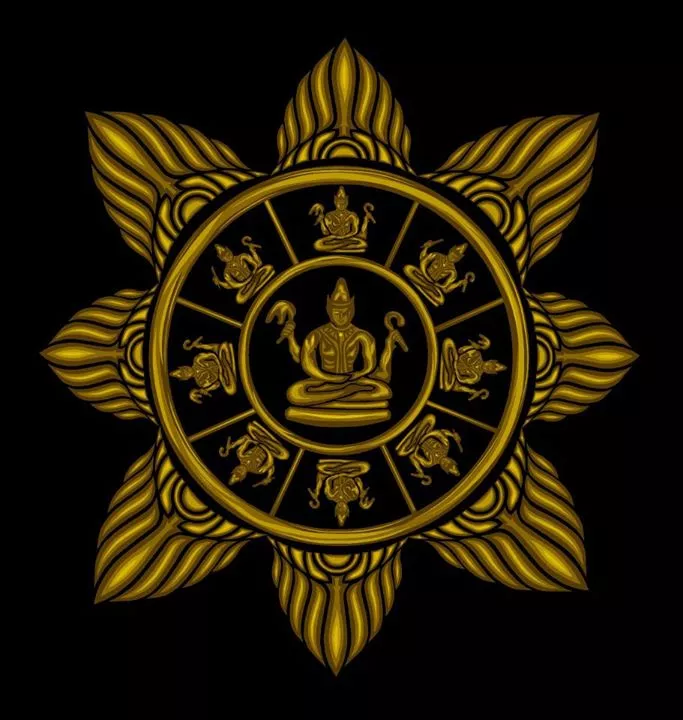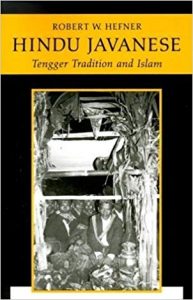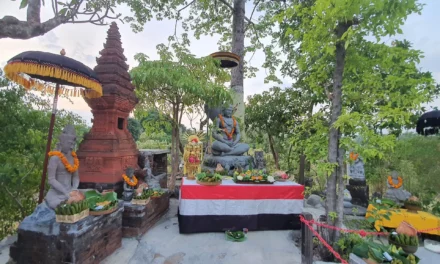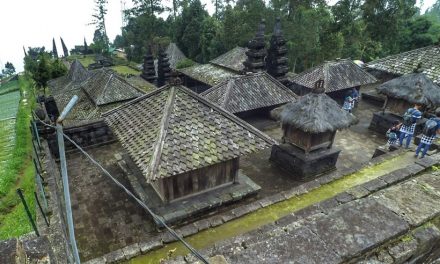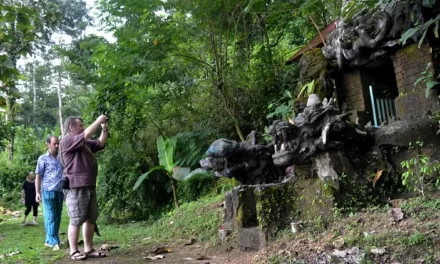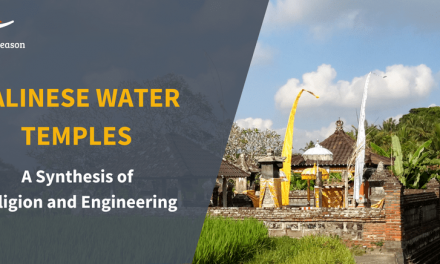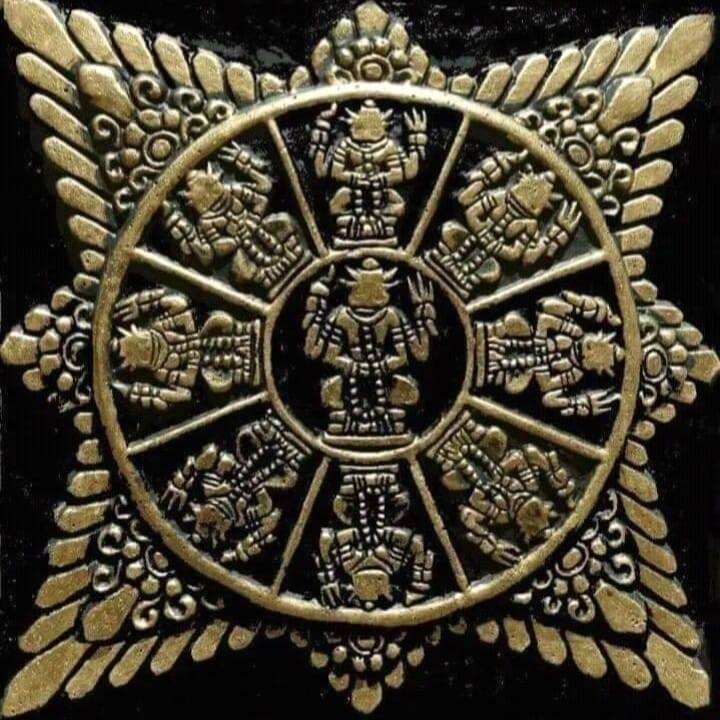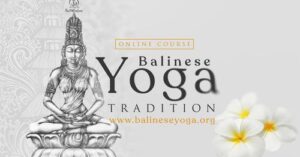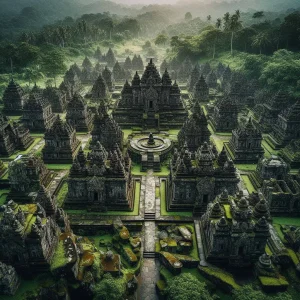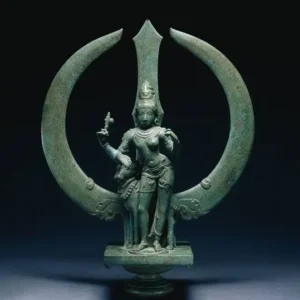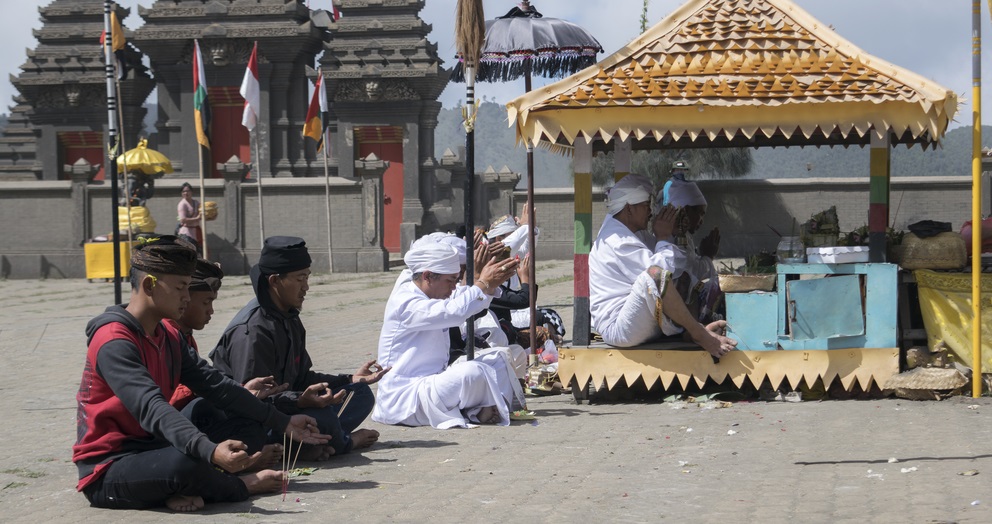
The Tengger people are one of the biggest Hindu communities in Java. Their population lives in the isolated Tengger mountains, around Pasuruan, Lumajang, Probolinggo and Malang.
The Tengger people are descendants of loyalists of the Majapahit empire who had resisted islamization for centuries in East Java and were driven into the mountains after the massive arrival in the area of Moslem Madurese in the 19th century. The Tengger initially numbered 600,000, but over the past decades, many have been assimilated into the immigrant Moslem population.
Tenggers are followers of the ancestral Indonesian Shiva-Buddha religion. About 80% of the Tengger people work as farmers. The fertility of the land makes it ideal for agriculture. They mold their life on the characters of the Ramayana and the Javanese Mahabharata.
Although the surrounding region is now predominantly Moslem, Islam was not well-established until the late 18th century. In addition, parts of the highlands have few orthodox Moslem influences, and have a strong Kejawen tradition.
Descendants of Majapahit
In his book ‘Hindu Javanese: Tengger Tradition and Islam’, Robert W. Hafner explains how the Tenggerese people are descendants of the Majapahit empire who escaped when the kingdom finally succumbed to the Islamist ”jihad” led by Raden Patah in the 16th century.
Subsequent persecution and conversion took its toll but many were able to retreat to Blambangan and Bali while many others chose to take refuge around the sacred Sumeru and Bromo mountains, isolating themselves from outside influences. It is these people who later became the Tengger ethnic community.
After Majapahit’s fall at the beginning of the 16th century, the center of power on the island moved west to Central Java. East Java was then left alone for the next two centuries, as these mountain Javanese were isolated from from the West.
After the fall of Majapahit and its capital of Wilwatikta about 90 km northwest, the Tengger massif and other East Javanese sacred mountains provided shelter for the Majapahit loyalists.
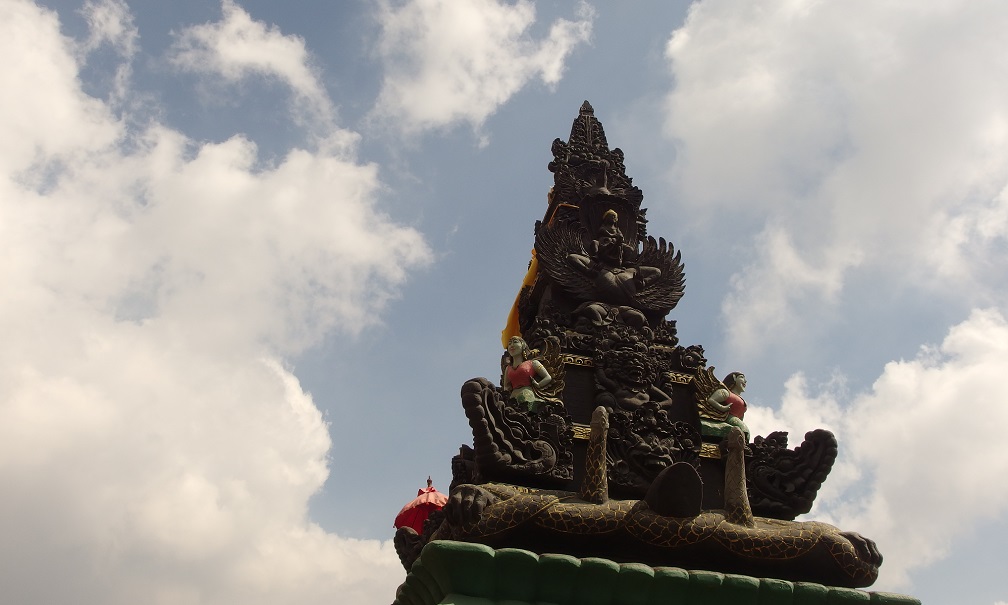
The padma candi, a Tengger-Javanese version of the padmasana
The Tenggerese’s Hindu Dharma
The Tenggerese are predominantly Shaivites. Like other Indonesian Hindus, the Tenggerese practice the Shiva-Buddha religion that also incorporate elements of ancestral folk religion and ancestor worship. They have a very complete spiritual worldview that includes both the world of the spirits and ancestors, as well as the highest deities, all the way up to Ida Sang Hyang Widi Wasa (God Almighty), or Parashiva.
Some of their practices offer an insight into the Majapahit religion, as they differ slightly from the Balinese Shiva-Buddha religious practice, which went through a reformation by Sang Hyang Nirartha after the fall of Majapahit.
They speak an ancient form of Javanese called Tengger, which is very close to to the sacred Kawi language, and are still using the Kawi script. Words that end in ‘a’ in Kawi and Sanskrit are also pronounced with word-final ‘a’ in Tengger Javanese, whereas in modern Javanese the convention is to pronounce the words with word-final ‘o’.
The Tengger religious worship is simpler than in Bali. They put the emphasis on secret mantras while making simple offerings of food and fruits. The mantras are either in Sanskrit or in Old Javanese (Kawi), which is very close to Sanskrit.
They also follow the Tri Sandhya system of mantras recited three times a day – at dawn (prātaḥsaṃdhyā), noon (mādhyāhnika) and dusk (sāyaṃsaṃdhyā).
The Majapahit religion: an integral spiritual worldview
While they make offerings to the spirits and deities like in all Asian religions, the Tenggerese, like other Indonesian Hindus acknowledge the presence of the ”monotheistic” God above and beyond all devas, or deities – Sanghyan Widhi (‘God Almighty’), or Para Shiva.
The Tenggerese worship God Almighty under His three separate manifestations, namely Brahma (called Sanghyang Geni) in Javanese, Vishnu (called Sanghyang Banyu) and Isvara/Shiva (called Sanghyang Bayu).
In addition to the manifestations of God, and of the devas, the Tenggerese also pay respects to the local spirits and to their ancestors. The Roh Bahurekso is the village guardian spirit and the Roh Leluhur are the spirits of ancestors.
This is of course often misunderstood by the surrounding Moslems, who allow only the worship of the monotheistic God, while ignoring all other aspects of the spiritual world, and tend to consider the practitioners of the original Asian religions as ‘polytheist’.
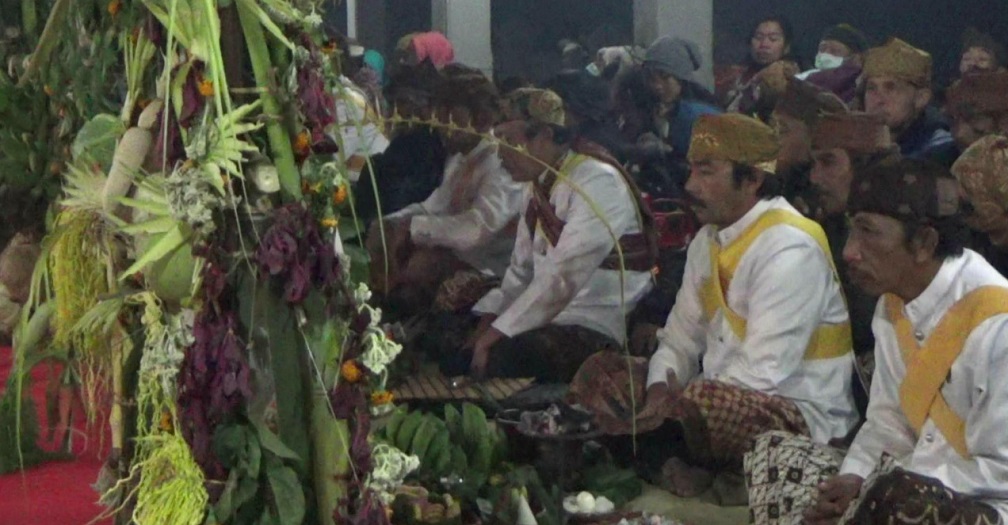
The Tenggerese’s Dharma is a harmonious syncretism of Hindu, Buddhist and Kejawen spirituality
The Tengger priesthood
The Tengger priests are called Dukun (which is the actual origin of the modern Javanese dukun, who are only healers, or black or white magicians), Romo or Resi Pujangga, depending on the context. Priesthood is hereditary and passes down from father to son. Each village has only one priest, with three assistants – Wong Sepuh, Legen and Wong Dandan, who is always a woman.
Just like in Majapahit times, the Tengger priests possess special knowledge of the gods and the spirits, which they carefully guard from ordinary people. Occult powers are transmitted through a secret training process, the culmination of which is a ceremony organised at the foot of Mount Bromo. All Tengger priests gather twice yearly to plan the festivals and discuss important issues.
The sanggar pamujan
Tengger villages do not have many large temples. Worship generally takes place at a little shrine called the sanggar pamujan. Sanggar means “gathering place” and comes from the Sanskrit sangha meaning “assembly.” This is where where offerings are made to the guardian spirits of the village.
Those shrines are found at the edge of each village in a grove of sacred banyan or cottonwood trees. The shrine contains no idols, and has space only enough for the priest to conduct his rituals. Shrines are built on an axis determined by the village’s relation to the sacred Mount Bromo, and their four-cornered roofs point in each of the four directions of the wind.
The correct relationship with the nine gods of the cardinal directions is central to the Javanese worldview. The east is identified with Ishvara, the south with Brahma, the west with Mahadeva, the north with Vishnu and the center with Shiva.
Tengger Hindu ceremonies
- The world-famous Yadnya Kasada sacrifice occurs one a year as a thanksgiving to Lord Brahma. This ceremony is always held at midnight during full moons.
- The annual Karo, or “all-souls festival” is performed to remove impurities from the souls of the dead, so that those spirits may rise to the heavens. The Karo is held in the second month of the year, and commemorates the souls of all the ancestors. It is an occasion for the ritual dance by special female performers known as tandak. The most remarkable moment in this ritual is when the priest calls upon Shiva in his wrathful manifestation as Kala Bhairava.
- Unan Unan is held every five years during the Tenggerese lunar “leap year” to clean the village from spirits and purify spirits so they can return to nirvana.
- Entas entas, held to purify spirit of dead people on the 1000th day after he or she died.
- Puja Mubeng, held on the 9th month of Tenggerese calendar or Panglong Kesanga, on the 9th day after full moon to avoid disasters.
- Others are related to marriage, family, birth and death
- The resi pujangga priests include a prayer known as the purwabumi (“Prayer of World Origins”), identical to the prayer of the same name recited in Bali by the resi bujangga priests, indicating the same Shaiva lineage that is found in large areas of Java and Bali.
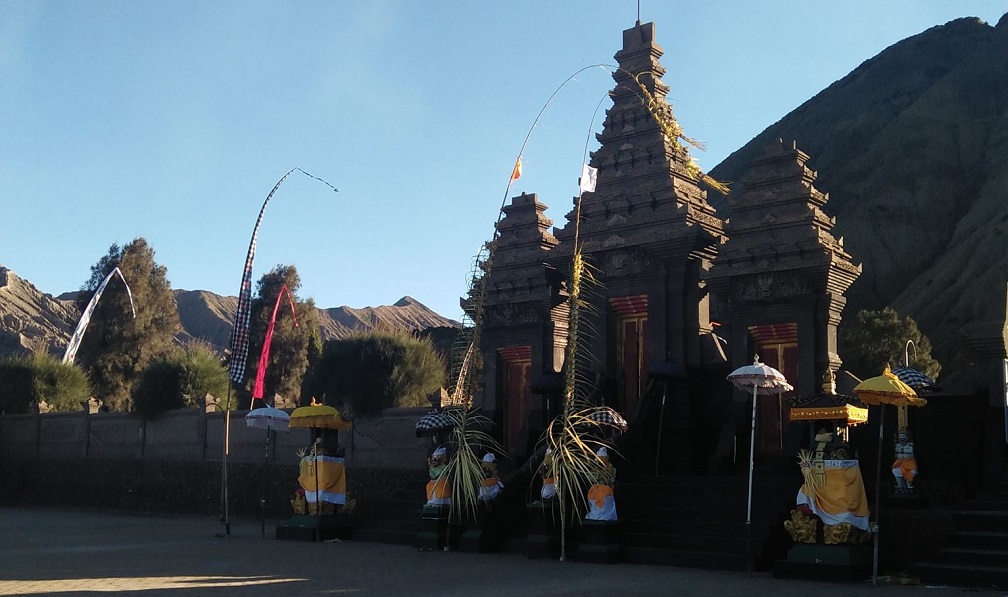
The central temple for the Tenggerese is Pura Luhur Poten, built in the Sand Sea, at the foot of Mount Brahma (‘Bromo’)
Rituals
Food offerings to the spirits take different forms:
- Sajenan are presented to the guardian deities by the priest. For different occasions different sorts of food are offered as sajenan. For instance, during weddings a cone of rice, tumpeng walagara, is offered.
- Tamping are presented to evil spirits so as to ward off bad luck, and typically consist of meat, rice and bananas wrapped up in leaves and placed at places considered inauspicious such as cemeteries, bridges and road intersections.
- Suguhan are offered by each family to their ancestral spirits.
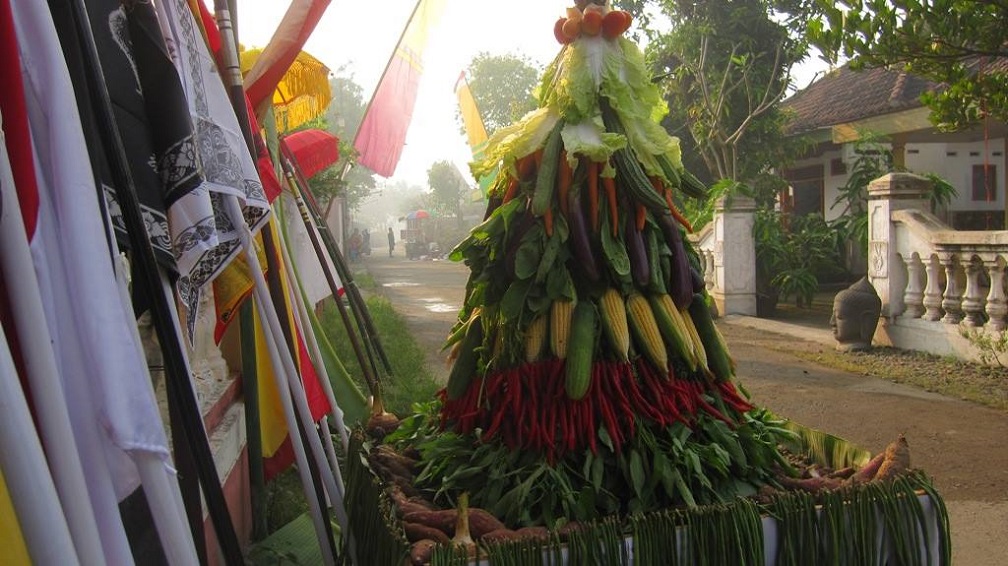
Tengger offerings in Javanese style
A sacred area since ancient times
In Majapahit times the Bromo complex was already a center of important ritual activity. In 1275, the community was xempted from all taxes because of the important religious work they did. But the Bromo-Sumeru region was home to both Shaivist and Buddhist clerical and monastic communities even since long before Majapahit times.
Even in the pre-Islamic period, the Tengger highlanders seem to have formed a separate community that worshiped Brahma at the crater of the volcano. The ancestors of today’s upper-slope Tengger Hindus were mountain Javanese whose priests in Majapahit times were members of a Shavaite clergy found today throughout East Java and Bali.
Some Tengger prayers are exactly similar to those found in modern Bali. Tengger Priests were once associated with a Tantric Shaivaite order known as the resi pujangga, genealogically related to the non-Brahmanic resi bujangga of modern Bali.
Tengger-Bromo-Sumeru in the Javanese scriptures
Javanese religious texts make numerous references to this unusual mountain highlands. Several Javanese texts link the Sand Sea around the Bromo volcano to sacred territories in classical Hindu cosmology.
An important work of the Majapahit period, the Tantu Panggelaran also mentions Mount Bromo as the spot where the god of fire, Brahma (from whom the name ‘Bromo’ is derived), does his smithing.
In the Nagarakertagama it is mentioned that King Hayam Wuruk, ruler of Majapahit, visited the Tengger massif for ritual purposes. For example, the royal procession visited a mandhala religious community in the district of Tongas, Probolinggo (on the northern slopes of the Tengger massif). There, it is said that he performed palukatan (water devotion) at a shrine, and received tribute from eleven Buddhist communities.
Today all of these villages mentioned in the Nagarakertagama lie just below the territory inhabited by the upper-slope Tengger – yet they had managed to remain free from Islamic well into the 19th century.
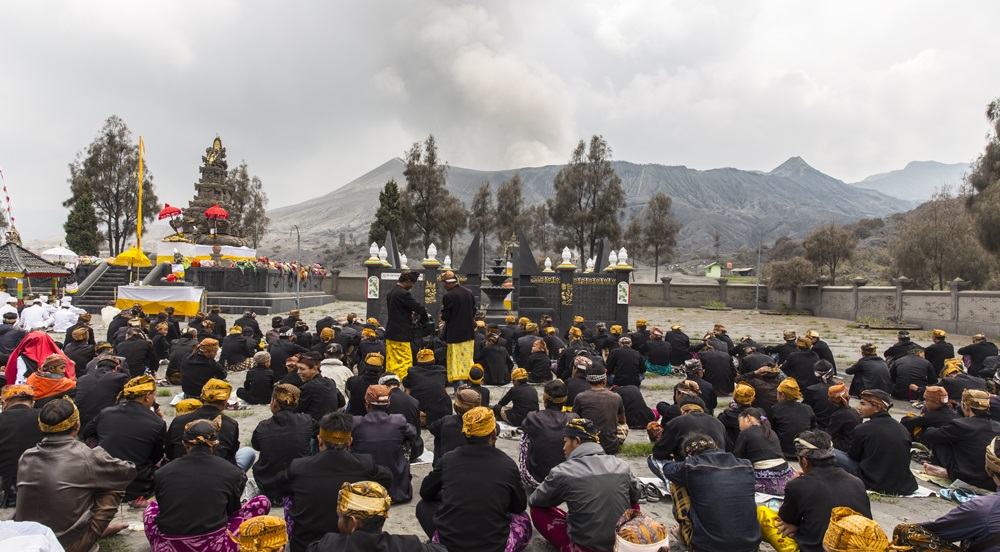
Tenggerese during Kuningan – Image source oysteinlundandersen.com
The Dutch conquest of East Java
In the 1680s, a Balinese ex-slave called Surapati launched multiple attacks against the Dutch in West and Central Java. He then had to flee east and established a court near Pasuruan at the northern foot of the Tengger mountains.
There, Surapati created a temporary anti-islamic alliance linking Pasuruan, Tengger, Blambangan and the Balinese, which manage to slow down the Mohammedans for a while.
In 1706, the Moslem Mataram kingdom forged an alliance with the Dutch VOC, and some 60,000 VOC, Mataram, and Madurese troops attacked Surapati’s stronghold near Pasuruan. Surapati was killed and Pasuruan was seized and turned into a Dutch fort.
For years, Surapati’s descendants continued to resist from hideouts in the Tengger mountains and Blambangan, where they eventually became the Osing people. The last Hindu-Javanese rebel leader in Tengger was captured by Dutch forces only in 1764.
To split the rebellious Blambangan kingdom from its Balinese allies, the Dutch used dirty tactics, such as encouraging the islamization of Blambangan in order to weaken this fierce kingdom.
Most villages remained Hindu until the 19th century, but this marked the end of Hindu kingdoms in Java. From then on, Javanese Hinduism was restricted to the rebel farmers population of the Tengger highlands.
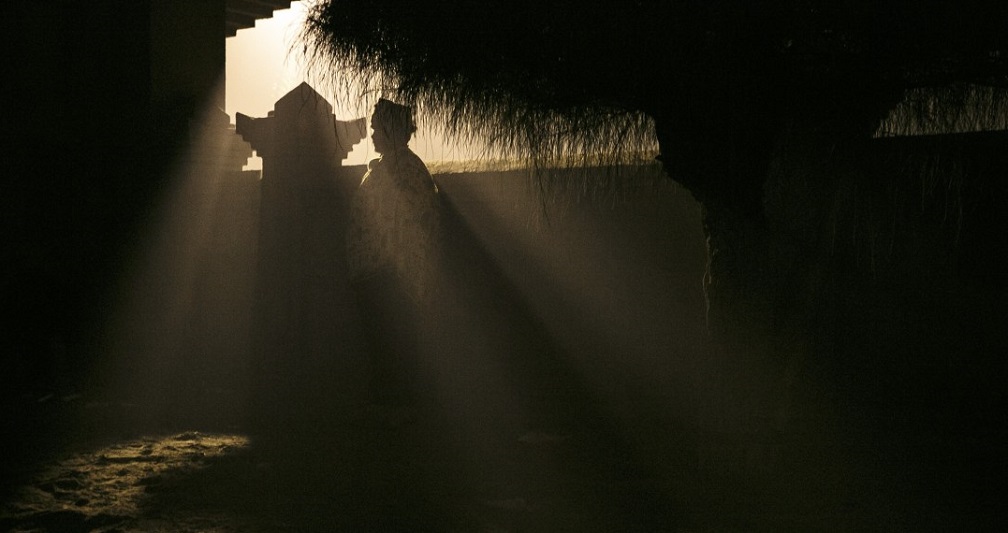
Centuries of resistance against the invaders
The Tengger endured 250 years of political violence. The constant warfare in the post-Majapahit period depopulated large areas of the countryside. By the end of the 18th century, the temperate mid-slope highlands had been depopulated. The surviving rebels took refuge in the less temperate but more defensible upper-slope areas.
Life was harsh. Village settlements had to be built on steep ridges, high above the cultivated valleys, and often remote from the water springs. Houses were built on terraces (gampengan), clustered tightly together. Yet these hilltop hamlets provided protection from the Mohammedan and Dutch attacks that plagued this region until the 19th century.
Their ranks were so depleted, however, that they would soon be overwhelmed by the Madurese and Javanese migrants who relocated to the area in the late 18th century.
The Dutch forces had decimated the Javanese population from Pasuruan to Blambangan. To continue their progression towards Blambangan, the Dutch encouraged Hindu conversions to Islam, so as to weaken their opponents. This explains how, although its mountain regions remained free from Islam, the lowland Pasuruan area later became one of the centers of Moslem radicalism in Java.
We know today about the Tengger and Blambangan cultures, because in these regions a critical mass of people and institutions survived. Many other loyalist Hindu-Javanese populations remained in other areas until the end of the 18th century, but we have few traces of them.
In the past few decades, due to overpopulation in Madura, more Madurese settlers have further moved into the Tenggerese lands, and holy shrines in the mountains are often being desecrated by the Moslem immigrants. Today, Tenggerese identity is still tested as the Tengger people have to define themselves in an islamizing Java under the constant influence of Moslem propaganda.
Read more: “Hinduism in Modern Indonesia: A Minority Religion between Local, National, and Global Interests”
